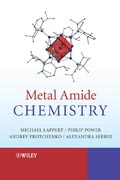
Written by internationally recognised leaders in the field, Metal Amide Chemistry is the authoritative survey of this important class of compounds, the first since Lappert and Power's 1980 book Metal and Metalloid Amides. An introduction to the topic is followed by in-depth discussions of the amide compounds of: alkali metals; alkaline earth metals; zinc, cadmium and mercury; the transition metals; group 3 and lanthanide metals; group 13 metals; silicon and the group 14 metals; group 15 metals; the actinide metals. Accompanied by a substantial bibliography, this is an essential guide for researchers and advanced students in academia and research working in synthetic organometallic, organic and inorganic chemistry, materials chemistry and catalysis. INDICE: Preface. Chapter 1: Introduction. 1.1 Scope and organisation of subject matter. 1.2 Developments and perspectives. Chapter 2: Alkali Metal Amides. 2.1 Introduction. 2.2 Lithium Amides. 2.3 Sodium Amides. 2.4 Potassium Amides. 2.5 Rubidium Amides. 2.6 Caesium Amides. References. Chapter 3: Beryllium and the Alkaline Earth Metal Amides. 3.1 Introduction. 3.2 Beryllium Amides. 3.3. Magnesium Amides. 3.4 Calcium Amides. 3.5 Strontium Amides. 3.6 Barium Amides. References. Chapter 4: Amides of the Group 3 and Lanthanide Metals. 4.1 Introduction. 4.2 The Pre-1996 Literature: Anwanders Review. 4.3 The Recent (post-1995) Literature. References. Chapter 5: Amides of the Actinide Metals. 5.1Introduction. 5.2 Neutral amidouranium(IV) and thorium(IV) complexes. 5.3 Neutral UIII Amides. 5.4 Neutral mixed Valence (UIII /UIV), UII, UV and UVI amides. 5.5 Amidouranates. 5.6 Amidouranium tetraphenylborates. References. Chapter6: Amides of the Transition Metals. 6.1 Introduction. 6.2 Transition metal derivatives of monodentate amides. 6.3 Polydentate transition metal amides. References. Chapter 7: Amides of Zinc, Cadmium and Mercury. 7.1 Introduction. 7.2 Neutral homoleptic zinc, cadmium and mercury amides. 7.3.Ionic metal amides. 7.4 Lewis base complexes, chelated metal amides and heteroleptic amido complexes. References. Chapter 8: AMIDES OF THE GROUP 13 METALS. 8.1 Introduction. 8.2Aluminium amides. 8.3 Gallium Amides. 8.4 Indium Amides. 8.5 Thallium Amides.References. Chapter 9: Subvalent Amides of Silicon and the Group 14 Metals. 9.1 Introduction. 9.2 Subvalent Amidosilicon Compounds. 9.3 Amidometal(II) chemistry [Ge(II), Sn(II), Pb(II)]. 9.4 Dimeric metal (III) imides: Biradicaloid copounds. 9.5 Higher-nuclearity group 14 metalloid clusters having amido ligands. References. Chapter 10: Amides of the Group 15 Metals and Metalloids. 10.1 Introduction. 10.2 Mononuclear group 15 metal (III) amides. 10.3 Oligomeric group 15 metal imides. 10.4 Mononuclear group 15 metal (V) amides. 10.5 Group 15metal (III) macrocyclic imides. 10.6 Miscelaneous group 15 metal-nitrogen compounds. References.
- ISBN: 978-0-470-72184-1
- Editorial: John Wiley & Sons
- Encuadernacion: Cartoné
- Páginas: 376
- Fecha Publicación: 16/01/2009
- Nº Volúmenes: 1
- Idioma: Inglés
